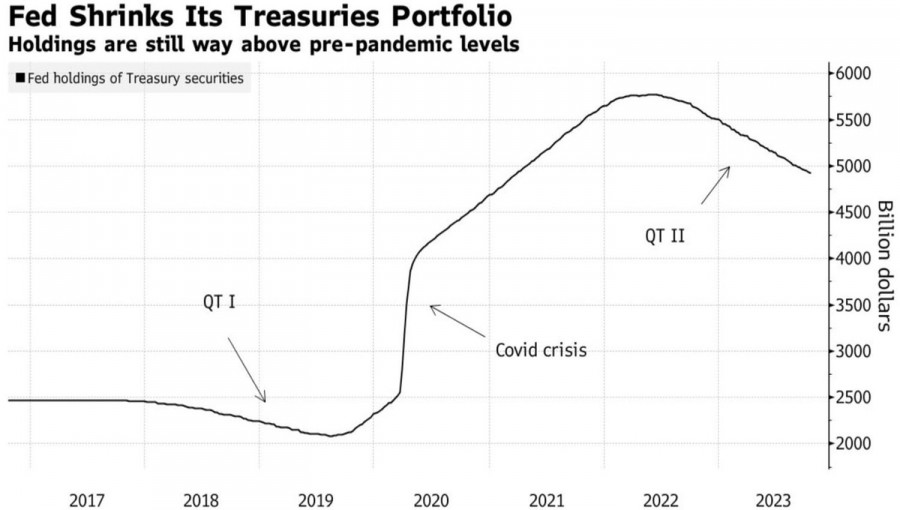
The American economy operates on a "the better, the worse" mode. The stronger the data that emerges, the higher the chances of the Federal Reserve resuming its monetary tightening cycle. Consequently, the probability of a recession increases. The longer the $720 billion per year quantitative tightening program continues, the higher the yields on U.S. Treasury bonds rise. This, in turn, adds to the challenges faced by the central bank and amplifies the risks of a political crisis. All of these factors make it difficult for the bears on EUR/USD to push the pair back to parity.
The Federal Reserve had previously emphasized that quantitative tightening (QT) could continue even after lowering the federal funds rate. However, the central bank is now concerned about the impact of the program on bond yields. As a result, there have been comments from FOMC officials indicating that the rally in the debt market rates is becoming part of the Fed's work. This is a clear sign of concern. In reality, if the quantitative tightening program were paused, it would likely unsettle the markets far more seriously.
Dynamics of the U.S. Treasury bond reserves

Looking at the negative repercussions of American QT, the ECB may start to reconsider its approach. The markets expect the European Central Bank to maintain the deposit rate at 4%, employ hawkish rhetoric, and discuss the details of its asset sales program. The latter is capable of pushing European bond yields even higher and potentially causing the Eurozone's economy to freeze. Judging by the PMI dynamics, the currency bloc could face a recession in the latter part of 2023. So why bury it even deeper?
Having the Federal Reserve's example in mind, European Central Bank President Christine Lagarde and her colleagues will be very cautious. It is more likely that QT will proceed very slowly. If, in addition, Lagarde declares progress in combating inflation, it could spell trouble for the euro. Investors will not only believe in the end of the monetary tightening cycle but also start betting on an earlier dovish pivot. Currently, derivatives indicate that the first act of monetary expansion by the ECB will take place in June 2024.
Optimistic forecasts of U.S. GDP accelerating from 2.1% to 4.2% in the third quarter are also supporting the bears on EUR/USD. Amid the de-escalation of the Middle East conflict, which had seriously muddied the waters, the factor of American exceptionalism reemerged. This was aided by the divergence in business activity between the United States and the Eurozone. While the U.S. Purchasing Managers' Index (PMI) rising above 50 signals GDP expansion and gives the Federal Reserve the opportunity to raise the federal funds rate, in Europe, things are much worse.

The currency bloc's economy is developing in a "bad, but it can get even worse" format. The PMI, which has fallen to the very bottom since 2020, and if we exclude the pandemic, since 2013, signifies serious problems.
Technically, on the EUR/USD daily chart, the "Splash and Shelf" pattern has transformed into a "Bull Trap." The unsuccessful attempt by the "bulls" to take the pair beyond the consolidation range of 1.05-1.064 may prove costly. In theory, a drop below the middle of the trading channel near the 1.057 mark could be a reason for selling.